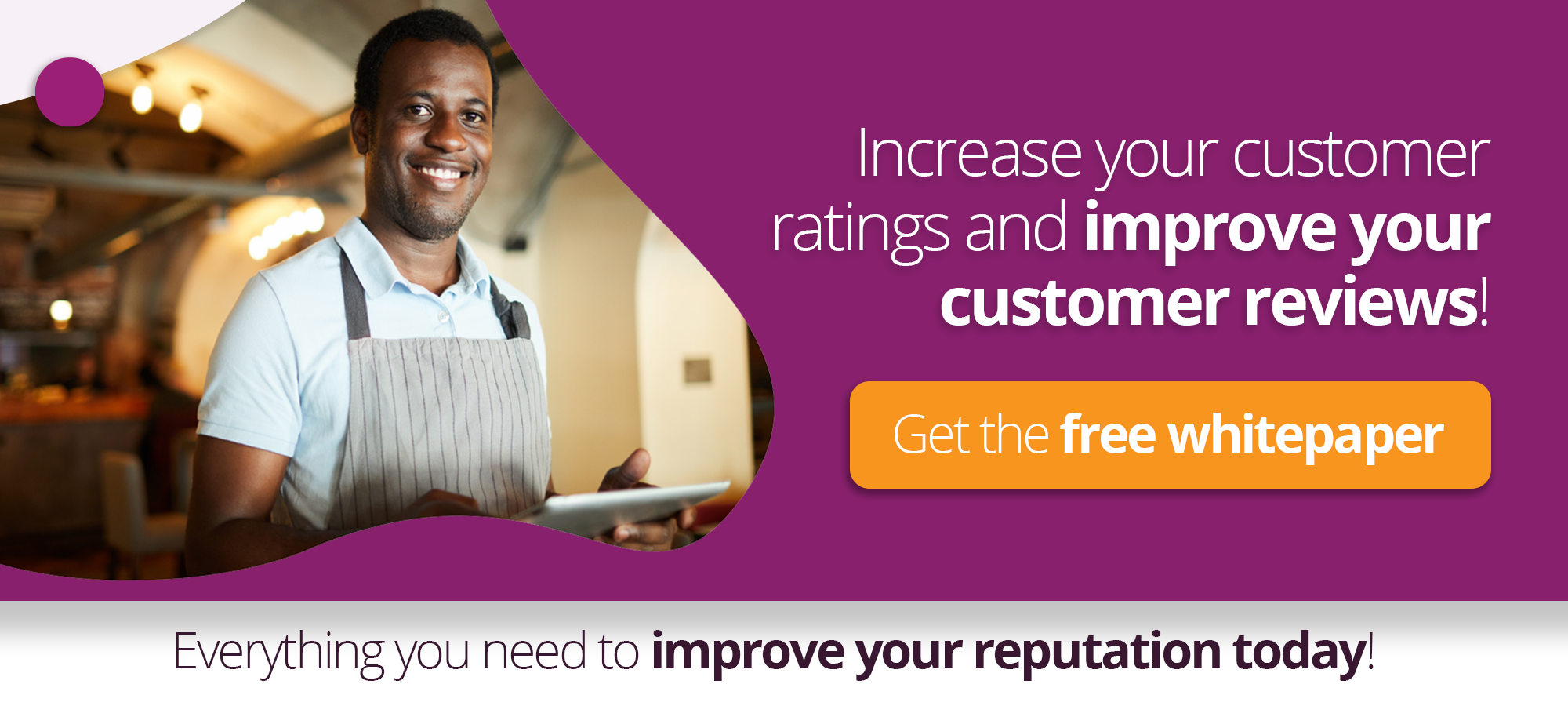Why is Restaurant Reputation Management Important?
Restaurant reputation management is a very important aspect of executing a successful restaurant marketing plan.
Your reputation, online or offline, can literally make or break your restaurant business. It can make the difference between having a wait-list, or having a sparse dining room with too many empty seats.
This is why actively managing your restaurant reputation is crucial for a profitable, growing business.
 We all know it is important to grow a more positive reputation. However, it is just as important to manage any poor customer experiences effectively.
We all know it is important to grow a more positive reputation. However, it is just as important to manage any poor customer experiences effectively.
This can lead to turning a poor experience into a loyal, happy patron ready to spread the good word.
A very large part of reputation management is monitoring and improving your online customer ratings and reviews.
According to Modern Restaurant Management, an increase of just one star can give a business an approximate 5-9% increase in revenue. And an increase of just one-half star would likely fill your seats during peak business times.
They also reported that 34% of diners choose a restaurant based on peer review websites.
And 53% of 18-to-34- year-olds reported that online ratings and reviews factored into their dining decisions. Therefore, reputation management should be a very important part of your restaurant marketing plan.

Managing Online Ratings and Reviews
According to a Time.com article, customer ratings are dominated by 5’s and 1’s and largely lack anything in the middle.
This happens because most customers who take the time to leave a review either had an amazing experience or a terrible one.
Customers who had a realistic or ordinary experience are just not motivated to leave any kind of review at all.
To overcome this, don’t be afraid to ask your customers to leave a review for you online.
According to a 2017 BrightLocal Local Consumer Review Survey, 68 percent of consumer respondents actually left a local business review when asked to do so.
The study also showed that responding to these ratings and reviews is more important than ever.
Responding to Poor Ratings and Reviews
A study by TNS NIPO researched over 2,000 negative online customer ratings and concluded that overall 70 percent of complainants hope to receive a response, while just 38% receive one. According to TNS NIPO, the success of the response is determined by 3 factors:
- The speed of the customer review response time.
- The quality of the solution provided to the customer.
- How the response is provided, and how genuine the response is perceived.
Likewise, the willingness of consumers to consequently recommend the brand again can be doubled (3.4 to 7.2) by combining these three factors effectively.
Your first thought after seeing a bad rating or review may be to fire back and defend yourself. However, this could actually damage your reputation even more.
Instead, embrace the feedback. Try to understand where the customer is coming from and respond with TACT.
- Thank them
- Apologize
- Continue the conversation offline
- Treat them
Thanking the customer will let them know that you care about your customers and reputation.
Remember that your response will be seen not only by the reviewer but by everyone else who reads the review.
When apologizing, be as sincere as possible. Apologize for either the condition, or for their experience as a result of the condition.
Continuing the conversation offline is important, but make sure to request this in the initial response. Offer your business email address or phone number.
That will let the public know that you want to work with the reviewer to make things right.
Finally, offer the guest an incentive to return to your restaurant and give you another chance.
Responding to Positive Ratings and Reviews
 Responding to positive reviews can greatly improve the reputation of your restaurant.
Responding to positive reviews can greatly improve the reputation of your restaurant.
Most business owners will simply leave positive reviews alone. However, responding to them can greatly boost the effectiveness of that review.
Make sure to respond to these reviews in TIME.
- Thank them
- Identify your business or location
- Market (just a little)
- Engage them
With any review, you should always thank the customer for taking the time to review your business.
In addition, you want to describe your business or location. For example, you can include a sentence like, “As downtown’s oldest premier Italian restaurant…”
Likewise, you should include some kind of marketing statement, such as how you provide a free drink or dessert for customers on their birthday. Make sure not to be too salesy or promotional.
Finally, it is important to engage the customer with a question, an invitation to come back, or asking them to share the word with friends and family.
The upside to responding to negative and positive ratings and reviews can make a huge difference in customer loyalty, customer service recovery, and new customer acquisition.
Ratings and reviews are just one item to focus on for effective restaurant reputation management. Here are some other things to keep in mind when creating a restaurant marketing plan.
Offer the Best Food & Drink and a Great Ambiance for Better Restaurant Reputation Management
Of course, if your food is under par, your restaurant reputation management will be much more difficult.
Always talk to your customers after they have had a chance to complete their meal. Ask them how it was.
Over time, you will be able to take that feedback and improve your overall food and drink offerings. In turn, your reputation will inherently improve.
Likewise, if your front-of-house is unkept or the wrong environment for your ideal customers, your reputation can suffer.
You will need to understand who those customers are and what their preferences might be.
Do they prefer more dim lighting? Do they want TV screens? Or, do they prefer a specific style of music?
Again, engage with your customers and make sure to take their feedback seriously.
Ensure the Best Customer Service Possible
 Almost nothing can damage a restaurant’s reputation faster than consistently poor customer service.
Almost nothing can damage a restaurant’s reputation faster than consistently poor customer service.
It is crucial to train all staff on how to provide outstanding customer service.
The training should include the proper way to handle any negative customer experiences.
Establish a culture of consistently great, memorable customer service.
Give your customers an experience they will remember and share with friends and family, online and offline.
Doing this and everything above revolves around knowing who your customers are, what they want, and how they behave while at your physical location.
Using WiFi Analytics For Accurate, Inexpensive Customer Data Collection
When it comes to restaurant reputation management and creating an effective marketing plan, knowing your customers is crucial.
In addition, you will need to monitor their ratings, sentiment, and behavior on an ongoing basis.
For most restaurant owners and operators, this is a daunting thought.
Likewise, they simply do not have the human resources to maintain this type of intense data collection and storage.
Fortunately, it is possible to use your guest WiFi access point to collect the very data you need.
Even if customers do not log into your WiFi, you can gather valuable customer behavior data.
For instance, you will see data like:
- Overall foot traffic
- Average customer dwell times and dwell times by the hour
- First-time visitors
- How many first-time visitors return
- Average customer repeat rate
- Popular visit days and hours
- Average customer churn rate, and more!
All of these data points can be viewed in any date span, which allows you to easily see developing or existing trends such as a spike in your churn rate or how many customers you are losing over time.
Or you might notice that your average dwell time of your customers is double at 8 am than it normally is at your location.
These types of data points allow you to hone in on potential customer issues before they make a bad review online.
In addition, for those with multiple locations, you can compare various locations or groups of locations for any of these data points for any date span.
Build Valuable Customer Profiles
Moreover, when a customer logs into your WiFi just once, all previous and future data associated with their device is added to a customer profile.
If they log in with a social media account, or multiple times, additional demographic data can be added to their profile, including:
- Age
- Gender
- Postal code
- Birthday
- Phone number
- Individual behavior data
Since they gave their email address to log in, you can now market to that person based upon their behavior and demographic data.
Knowing these things, your restaurant marketing plan can be personalized and targeted to their interests.
You can send a message that will truly resonate with the customer.
For example, you can send a survey to customers X amount of time after they have an experience at your location.
For instance, if the customer leaves a good rating, you can respond by thanking them, and then asking them to give you a positive online review.
By building positive online reviews you will ultimately drive more new customers to your locations.
In contrast, should they leave a bad rating, you can respond with T.A.C.T, including an apology and an incentive to get them to return and give you another chance.
Over time, this survey automation and auto predefined responses will actively build positive online reviews that build your restaurant’s reputation, along with customer satisfaction, spend and loyalty.
Grow Your Business with a Stellar Reputation
This is just the tip of the iceberg when it comes to restaurant reputation management and creating a marketing plan using WiFi marketing and analytics data.
The opportunities are endless, and you can get this data for pennies-on-the-dollar compared to other data collection methods.
Perhaps the most powerful way to boost revenue, improve online ratings, bring back lost customers, and improve customer lifetime values – all while saving time and money – is to invest in WiFi marketing and customer intelligence platform like Bloom Intelligence.
So, if you would like to see Bloom in action, and how easy it is to use, call us today to schedule a demo, or schedule a demo online here.




.svg)